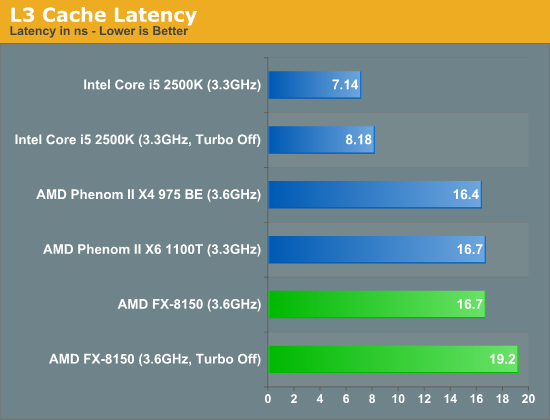The Bulldozer Review: AMD FX-8150 Tested
by Anand Lal Shimpi on October 12, 2011 1:27 AM ESTCache and Memory Performance
I mentioned earlier that cache latencies are higher in order to accommodate the larger caches (8MB L2 + 8MB L3) as well as the high frequency design. We turned to our old friend cachemem to measure these latencies in clocks:
| Cache/Memory Latency Comparison | ||||||
| L1 | L2 | L3 | Main Memory | |||
| AMD FX-8150 (3.6GHz) | 4 | 21 | 65 | 195 | ||
| AMD Phenom II X4 975 BE (3.6GHz) | 3 | 15 | 59 | 182 | ||
| AMD Phenom II X6 1100T (3.3GHz) | 3 | 14 | 55 | 157 | ||
| Intel Core i5 2500K (3.3GHz) | 4 | 11 | 25 | 148 | ||
Cache latencies are up significantly across the board, which is to be expected given the increase in pipeline depth as well as cache size. But is Bulldozer able to overcome the increase through higher clocks? To find out we have to convert latency in clocks to latency in nanoseconds:

We disable turbo in order to get predictable clock speeds, which lets us accurately calculate memory latency in ns. The FX-8150 at 3.6GHz has a longer trip down memory lane than its predecessor, also at 3.6GHz. The higher latency caches play a role in this as they are necessary to help drive AMD's frequency up. What happens if we turn turbo on and peg the FX-8150 at 3.9GHz? Memory latency goes down. Bulldozer still isn't able to get to main memory as quickly as Sandy Bridge, but thanks to Turbo Core it's able to do so better than the outgoing Phenom II.

L3 access latency is effectively a wash compared to the Phenom II thanks to the higher clock speeds enabled by Turbo Core. Latencies haven't really improved though, and Bulldozer has a long way to go before it reaches Sandy Bridge access latencies.










430 Comments
View All Comments
Ryan Smith - Wednesday, October 12, 2011 - link
Technically, both are correct. One of us wrote the text and the other wrote the diagram, and each of us picked a value; they just didn't match. Whoops. Fixedhttp://www.anandtech.com/show/4818/counting-transi...
octoploid - Wednesday, October 12, 2011 - link
Anand,are you sure that you have used the right -j number
in this benchmark?
The Bulldozer performance almost look too bad to be true.
http://images.anandtech.com/graphs/graph4955/41699...
Look at these pictures for comparison:
http://www.hardware.fr/medias/photos_news/00/33/IM...
http://www.hardware.fr/medias/photos_news/00/33/IM...
FlanK3r - Wednesday, October 12, 2011 - link
good review La Shimpi. For OC...I think, it is no problem hit 4.8 Ghz stable, but you need better aircooler (some Noctua or so). I hit with D14 4840 MHz stable. Boot up to 5050 MHz. 5250 MHz validation.BR FlanK3r
Cygus - Wednesday, October 12, 2011 - link
Apparently AMD is busy with some sort of bulldozer optimization patch for windows 7. Anand, will you guys be updating your benchmarks once this comes out?Sigh, I was really hoping for better competition to drive the prices down.
BSMonitor - Wednesday, October 12, 2011 - link
"Sigh, I was really hoping for better competition to drive the prices down. "Down from what? These are the same price points that have existed for a decade. You would simply get more performance at the same price point!
Kjella - Wednesday, October 12, 2011 - link
Going from 85W to 229W in power consumption is 144W. If we assume a 80% efficient PSU that's 115W + 10W idle so it's completely maxing the TDP. Look at it, it's almost 100W over the 2500K which is what it's most competitive with. I can't see that being popular at home or in the server space, expensive and a huge problem to cool sufficiently. And that die size, it must cost tons to produce so the margins must be slim and none so crap for customers, crap for AMD. I didn't dare get my hopes up very high but this I would call a total disaster. I honestly did not think it could get this bad.ninjaquick - Wednesday, October 12, 2011 - link
BD seems to be very forward looking, and I think it will be worth it. Look at 7-zip vs Winzip perf (can't remember who did the comp), but BD was worst in WinZip and fastest in 7-zip, like, slower than propus and faster than sandy bridge. Intelligently threaded games really rock with BD but older or less technical games tank with BD.I agree with others that this is more of a 4 core 8 thread CPU, but honestly, counting cores is dumb. Threads are what matter and this can run 8 side by side without adding latency, unlike intel's HT.
And really, clockspeed was 'abandoned' because it wasn't really feasible to pursue it any higher, but properly executed, a high clock solution can allow for deeper pipes without sacrificing latency too much, achieving more per clock at a higher clock rate. And from what I've seen on the powerconsumption side of things, 4.6 doesn't draw as much as 3.7 on my PhII.
IceDread - Wednesday, October 12, 2011 - link
Actually, performance and watt is what matters and this cpu fails horribly in so many areas. This product would have been better of unreleased. You'd have to be somewhat insane to purchase it.FunBunny2 - Wednesday, October 12, 2011 - link
wrong. a thread is a fake core. a core is a real core. a thread shares the core with the rest of its threads. more cores, more fun.silverblue - Thursday, October 13, 2011 - link
Not if "A single Bulldozer module can switch between threads as often as every clock."